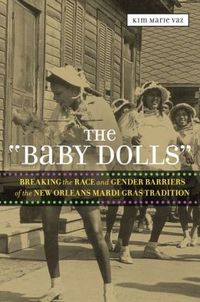

Purchase
Breaking the Race and Gender Barriers of the New Orleans Mardi Gras Tradition
Louisiana State University Press
January 2013
On Sale: January 18, 2013
216 pages
ISBN: 0807150703
EAN: 9780807150702
Kindle: B00B02ASU4
Paperback / e-Book
Add to Wish List
Non-Fiction History
One of the first women’s organizations to mask and perform
during Mardi Gras, the Million Dollar Baby Dolls redefined
the New Orleans carnival tradition. Tracing their origins
from Storyville-era brothels and dance halls to their
re-emergence in post-Katrina New Orleans, author Kim Marie
Vaz uncovers the fascinating history of the “raddy-walking,
shake-dancing, cigar-smoking, money-flinging” ladies who
strutted their way into a predominantly male
establishment.
The Baby Dolls formed around 1912 as
an organization of African American women who used their
profits from working in New Orleans’s red-light district to
compete with other Black prostitutes on Mardi Gras. Part of
this event involved the tradition of masking, in which
carnival groups create a collective identity through
costuming. Their baby doll costumes—short satin dresses,
stockings with garters, and bonnets—set against a bold and
provocative public behavior not only exploited stereotypes
but also empowered and made visible an otherwise
marginalized female demographic.
Over time,
different neighborhoods adopted the Baby Doll tradition,
stirring the creative imagination of Black women and men
across New Orleans, from the downtown Tremé area to the
uptown community of Mahalia Jackson. Vaz follows the Baby
Doll phenomenon through one hundred years with photos,
articles, and interviews and concludes with the birth of
contemporary groups, emphasizing these organizations’
crucial contribution to Louisiana’s cultural history.
Comments
No comments posted.
Registered users may leave comments.
Log in or register now!
| 


 © 2003-2025 off-the-edge.net
all rights reserved Privacy Policy
© 2003-2025 off-the-edge.net
all rights reserved Privacy Policy